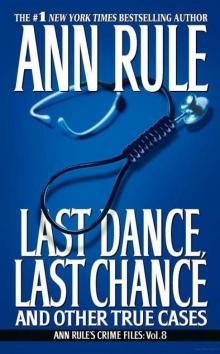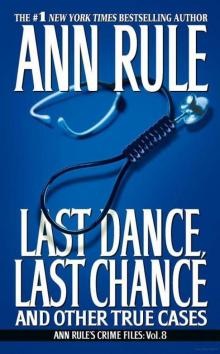The I-5 Killer Read online
Page 3
Precious little information for officers going into an unknown situation where a suspect is armed with a gun. But that was all Liz Cameron had been able to elicit from Beth Wilmot. If the man was still in the building — a building with windows on all four sides — no deputy going in would have a chance.
With a wounded victim — probably two wounded victims — in the building, no deputy had a choice.
Roger 9, Reserve Deputy Greg Roach, was the first deputy to arrive at the TransAmerica Title Building. He made the River Road address in a minute and a half with blue lights revolving and siren screaming. The aid unit from the Keizer Fire Department had arrived thirty seconds earlier. One of the emergency medical technicians ran over to him.
"There's someone moving around in the building."
Roach looked into the glass-walled structure and saw a naked female in the main office portion; she was walking toward a smaller office located in the southwest corner of the building. When he looked in that direction, he saw a second young woman lying on the floor in a prone position. She too was nude. Her face was turned away from his view, but he could see a spreading pool of blood around her head. For just a moment he felt as if he were viewing a movie screen showing a horror film instead of seeing reality, shockingly true, in the well-lit building.
Roach instructed the fire personnel to wait outside, drew his service revolver, and entered the building. He dared not wait for backup from other deputies. The women inside might die if he did. He felt the hairs prickle at the back of his neck as he checked each room for a suspect who might be waiting with his own gun ready. The offices, the restrooms — all empty. Roach came to one locked door. He debated only a second. He kicked the door and the lock gave. The room was empty.
Roach signaled to the paramedics that it was safe to enter. There was no place else inside where the assailant might be hiding.
Sergeant Will Hingston in Unit 112 arrived sixty seconds after Deputy Roach, and within minutes the building was surrounded by every Marion County officer available in that section of the county: Deputies Bernie Papenfus, Frank Crandall, Don Dolan, John Braun, Detectives Dave Kominek and Jay Boutwell, Lieutenant Kilburn McCoy, Captain Richard Bay, and Undersheriff Robert Prinslow.
The Keizer fire chief, John Sanford, and his emergency medical technicians and paramedics advised the lawmen that there seemed to be two grievously wounded young women.
Beth Wilmot was in deep shock; she was unaware that she was nude, and the paramedics covered her with a blanket. One of her eyes was blackened and the right side of her face was oddly swollen and bruised. Blood oozed from a spot near her right ear.
When a medic examined her, he gasped and looked up in amazement.
"She's been shot in the head. We'll have to transport her at once."
Deputy Bernie Papenfus was assigned to ride in the ambulance with Beth as she was rushed to Salem Memorial Hospital.
The other victim, the girl Beth had said was Shari Hull, was in much worse shape. She was comatose, and the Keizer paramedics found that she had sustained three wounds to the head, wounds that appeared to have been caused by bullets. Shari's vital signs were almost too faint to be measured. The medics shook their heads as they attempted to find some indication that the slender girl might survive. They "bagged" her — forced oxygen into her lungs — as she was lifted onto a gurney and wheeled rapidly toward an ambulance.
Accompanied by Detective Boutwell and Deputy Dolan, Shari too was rushed to Salem Memorial.
Beth remained amazingly coherent as she rode in the ambulance. She was able to tell Deputy Papenfus that she and her best friend, Shari, cleaned the TransAmerica Building every Sunday.
"We were almost finished. Shari went outside to her car, and I had a little cleaning left to do. I was just rounding a corner, going toward the entrance, when I saw Shari and this man walking toward me. He had a long-barreled gun in his right hand. He took us to a room and told us to take off all our clothes — that he wouldn't hurt us. He made us lie down on the floor. We did that, and then he shot Shari in the head, and then he shot me. I pretended to be dead, and I could hear Shari moaning. Then I heard another shot, and heard him — the man — leave. When I was pretty sure he was gone, I crawled to the phone in the office and called the fire department."
"Had you ever seen the man before?" Papenfus asked.
"No."
"Did he molest — bother — either of you?" Papenfus asked gently. "Did he rape you?"
"No … " the girl whispered, and added somewhat obscurely, "No, I never touched him."
Perhaps the shock and her terrible wounds had temporarily blocked the ugliest memories for Beth Wilmot. Perhaps she could not yet bring herself to tell anyone what the man had done to them.
Papenfus sensed a rage in Beth. She was shaking from shock, but she was also livid with anger that a stranger could have shot her and Shari. She insisted on giving a description of their attacker again.
"He was a white man, in his mid-twenties, five-feet-eleven to six feet. Slender build. Dark brown hair. Hooded black leather waist-length jacket. Band-Aid … a Band-Aid on his nose."
Beth was not as sure about the gun; she wasn't familiar with guns. Papenfus made a move to show her his own service weapon for comparison purposes, but the sight of a gun — any gun — sent Beth into hysterics, and he quickly slipped the gun back into its holster.
Again and again Beth begged Papenfus, "Will I be all right? Am I going to die?"
Papenfus assured her that she would be all right, although looking at the blood, her blackened eye, and swollen face, he was not sure.
"Shari!" Beth kept asking. "Is she all right? Is she gonna die? She was breathing so funny, and moaning, and she wouldn't talk to me. Is Shari gonna die?"
The deputy didn't want to answer that question. Shari Hull had lain so quietly on the lunchroom carpet, and there had been so much blood, pints of it seemingly, seeping steadily from her head, and a slight protrusion of brain matter from the wounds. Papenfus knew that it would take a miracle for Shari Hull to survive.
There would be no miracle. Shari Hull, twenty years old, died in the emergency room of Salem Memorial Hospital at one-twenty A.M. without regaining consciousness.
While Bernie Papenfus waited outside the emergency room for Beth to be examined, a memory kept coming back to him — a recent memory. While he was racing to the TransAmerica Building on the Code 3 call, he had rounded the corner of Broadway and Pine Street at about four minutes after ten. He had just heard the description of the suspect given by the dispatcher, the same description that Beth would repeat to him later in the ambulance. At that moment, as he turned the corner, he had seen a man standing in a well-lit area only ten feet from his patrol car. The man had stared back at him boldly, almost challengingly. It was one of those moments that are over almost with the blinking of an eye but which etch themselves indelibly in the subconscious mind, only to be recalled later in perfect detail. The man had worn jeans and a fleece jacket — but Papenfus had had the impression that the jacket was turned inside out.
That corner had been 1.2 miles from the shooting scene. Only an athlete could have run so far in the short time since the first call for help had come in. But it was possible to cover a mile in that time, if the runner was young and in prime condition.
Papenfus had eased his foot onto the brake pedal and had radioed for a better description on the suspect, but then another deputy's voice had cut into the radio with the report that the gunman might still be in the building at the crime scene. Papenfus had hit the accelerator then and headed for the shooting scene. Now he remembered the man standing on the corner, the dark eyes that had stared back at him without flinching. He saw that face in his mind; he would never forget that face. What if he had stopped and questioned the guy? He berated himself that he had not, but hindsight is always clearer. Papenfus had assumed that he was needed to back up officers at the shooting scene. No, knowing what he knew at the time, he should not have stopped.
>
In his own mind the deputy was sure that he had stared into the eyes of the killer. And now the killer was long gone.
The physicians treating Beth Wilmot looked at the slender dark-haired young woman who seemed younger than the age she gave them — twenty — and marveled that she still lived, although her condition was clearly critical. When they had washed the blood from her face and hair, the doctors found a flattened slug, probably a .32-caliber bullet, nestled in the matted hair at the back of her head. It had not penetrated the skull, but the force from the bullet would have been powerful enough to knock her off her feet. The ammunition might have been old, or it might have been fired from a gun of the wrong caliber, or Beth Wilmot might be one of those rare individuals whose skull density is thicker than normal — thick enough to protect the brain even against a bullet.
Moreover, X rays indicated that there was a second bullet, a slug that had penetrated the scalp at the back of Beth's head, but, again, not the skull. This bullet had only plowed a furrow beneath the skin on the right side of her head and come finally to rest just in front of her ear. Beth Wilmot had beaten death. Twice.
Dr. Robert Buza removed this second bullet and turned it over to Detective Jay Boutwell, who entered it into evidence, along with the first bullet found in Beth's hair.
Beth had denied that the gunman had sexually attacked either her or Shari when she gave her first statement in the ambulance, but swabs were used to check for the possible presence of semen in the mouths, rectums, and vaginal vaults of the two victims. These swabs were then saturated with acid phosphatase. The telltale bright pinkish-purple reaction that indicates the presence of male ejaculate appeared on the swab from Beth's throat.
The killer had ejaculated into her mouth.
Beth had not lied; Beth had only denied the memory of the nightmare she had endured. Later, she would remember … and wish that she had not.
Dave Kominek was one of the two detectives on call that dark night in January. He had already responded to one homicide scene earlier in the day, and now he'd been summoned to the shooting scene. Detective Jay Boutwell was at the hospital, and Kominek would remain at the TransAmerica Building to process the crime scene.
Kominek is a compactly muscled, intense man, still in his thirties, and he can seem deceptively easygoing off the job. But Dave Kominek was a detective who had already been involved in most of Marion County's most intricate homicide probes. And the county, situated in the idyllic Willamette Valley, had had several bizarre murders in the past half-dozen years — not easy to solve, but solved.
Married and the father of two sons, Kominek does not come from a family of lawmen, nor did he grow up with a burning ambition to be a cop; he looked upon law enforcement initially as just another job. It was to become a way of life for him.
Kominek speaks with the "Oregon drawl," a pattern of speech common to the area around Salem, an accent that sounds almost southern to the untrained ear. Like many Oregon detectives, Kominek wears cowboy boots, although the "Old West" lives in most of Oregon only in history books. The band of his hat is a real rattlesnake. He traps the snakes himself, and fashions the distinctive bands. He skis — both snow and water — in his spare time, plays tournament golf, and he built his family home from the ground up, but his true love is police work.
Born in Nebraska, Kominek moved to Salem with his family when he was ten years old. He grew up there, the middle son in a family of three boys. "We're one hundred percent Czechoslovakian on both sides — both my mom and dad," he comments.
After graduating from high school in 1964, Kominek married. "My friends told me I was crazy to get married so young." He laughs. "But that was the smartest decision I ever made."
He joined the Air Force and was sent to Vietnam on a flight crew, where his job was "basically balancing airplanes. I was a load master on a four-engine turbo-prop C-130."
After Vietnam, Kominek was assigned to a base in South Carolina, where he served for two more years on a flight crew as a load master on C-141 so "It wasn't a difficult job; those are the most forgiving airplanes flying." The Komineks' son Eric was born while they were in South Carolina.
Back in Oregon after his service stint, Kominek attended Oregon State University for three years, taking engineering and business courses. Police work was the farthest thing from his mind.
But by now, Kominek and his wife, Gail, had a second son, Chad, and family responsibilities demanded that Dave take a full-time job before he could graduate from Oregon State. He bought a truck, but the man he worked for went bankrupt. He applied for several jobs, including that of deputy with the Marion County Sheriff's Office. "I had halfway decent qualifications. I'd never been in trouble — and that was the main qualification. They hired me."
That was in February 1973. In March 1974 Kominek went undercover, working narcotics investigations. He grew a beard and long hair and wore the garb of the "doper." His own mother wouldn't have recognized him on the street. He was a member of MINT (Marion Interagency Narcotics Team). After some tense experiences during his year as a narc, Kominek moved into the Detective Unit.
He had scarcely had time to become oriented to his new assignment when he and Detective Sergeant Jim Byrnes were plunged into the macabre investigation of the murder of a woman whose mutilated body was found — literally in sections — floating in a river outside Salem. They identified the victim as a woman visiting relatives in the Salem area. The last time anyone had seen her alive, she had been having a drink at a popular restaurant. The only physical evidence Byrnes and Kominek had was a receipt from a local dump, but the two detectives used that — and a lot of legwork — to trace the killer, a recent parolee from the Oregon State Penitentiary. The man had been sent up a dozen years before for an almost identical crime. His victims were all strangled and then dismembered.
"Jim and I worked the same way — all-out. That usually meant thirty-six to forty-eight hours at a stretch, without sleep, until we found our killer. You can always catch up on sleep, but you can't afford to give murderers the luxury of time."
Kominek and Byrnes worked together for two years, a period of epidemic violent crime in Marion County, and Kominek learned rapidly. When Byrnes left the sheriff's office to become an investigator for the Oregon State Attorney General's Office, Kominek found himself the lead investigator of homicides in the Marion County Sheriffs Office. He was not quite thirty years old.
Kominek took advantage of every seminar and school available in homicide investigation on subjects ranging from blood-pattern evaluation to hypnosis of victims and witnesses. He was particularly fascinated with hypnosis as a tool in police work, and rapidly became adept at the sometimes controversial art that some experts feel can unlock the subconscious memory of those who have endured severe trauma. When he attended the homicide school at the Southern Police Institute at the University of Louisville — the homicide school in America — Dave Kominek ended up teaching the techniques of hypnotizing eyewitnesses.
As a homicide investigator, Dave Kominek proved to have that ability that all good detectives have, the innate sixth sense that makes him doubt the obvious, that compels him to dig beneath the surface of what seems to be the truth. One of his earliest cases involved the "suicide" of an older man, a boarder in a private home. "His landlady said he was depressed, that he'd just picked up her gun and shot himself in the neck. But something bothered me when I viewed the body at autopsy. For one thing, male suicides don't shoot themselves in the neck — they aim at their temples or into their mouths. Number two: there were no powder burns — none. We checked ballistics, and we found that old man would have to have had arms forty-two inches long — minimum — in order to shoot himself and leave no debris from the barrel around the wound. We went back and found there had been an eyewitness, another old guy who had been terrified to talk for fear he'd get shot too. He finally told us that the landlady had shot our victim — because he wouldn't run an errand for her! We didn't think she should go to prison
, because she was clearly off the track, but we wanted to find out the truth. She was committed to the state mental hospital."
Throughout the next years, Kominek worked dozens of murder cases, many of them taking him to distant parts of the United States before they were successfully concluded. He admits that he can be a stubborn bulldozer when he's working a homicide, although he is quick to give credit to other detectives and forensic science experts who have worked beside him.
On this gloomy Sunday night in January 1981, the term "I-5 Killer" had not yet been coined. None of the investigators knew that a Pandora's box of sexually motivated murders had been opened wide. What they did have was bad enough.
Kominek had already notified the office manager for TransAmerica, who came to the scene and viewed the offices. The manager found nothing missing. Obviously theft had been neither the primary nor the secondary motivation for the carnage.
Shari Hull's father, rendered almost speechless by the news of the shootings, had finally been able to explain that his janitorial service had no set hours for cleaning the TransAmerica Building, but that the building was the girls' assignment.
"Shari and Beth must have got there late; they had other buildings to clean this weekend — they should have been finished with the TransAmerica Building well before nine. But they were dependable — they would have worked past midnight if they had to to get it done."
The immediate concern in the aftermath of the first call for help had been, of course, the survival of the victims. That is always the first priority for police officers. If the victim is alive, or might possibly be alive, they must strive to preserve life at all costs. And so there had been paramedics walking through the crime scene, and many deputies helping to search and secure the building. It was only after Beth and Shari had been rushed to Salem Memorial Hospital that Dave Kominek had time to stand back and observe the shambles murder had left behind, and only then could he attempt to find something that the killer might have inadvertently left.

 Too Late to Say Goodbye: A True Story of Murder and Betrayal
Too Late to Say Goodbye: A True Story of Murder and Betrayal Green River, Running Red
Green River, Running Red Bitter Harvest
Bitter Harvest Dead by Sunset: Perfect Husband, Perfect Killer?
Dead by Sunset: Perfect Husband, Perfect Killer? Lust Killer
Lust Killer And Never Let Her Go: Thomas Capano: The Deadly Seducer
And Never Let Her Go: Thomas Capano: The Deadly Seducer But I Trusted You and Other True Cases
But I Trusted You and Other True Cases Smoke, Mirrors, and Murder and Other True Cases
Smoke, Mirrors, and Murder and Other True Cases If You Really Loved Me
If You Really Loved Me Kiss Me, Kill Me and Other True Cases
Kiss Me, Kill Me and Other True Cases Fatal Friends, Deadly Neighbors and Other True Cases
Fatal Friends, Deadly Neighbors and Other True Cases Practice to Deceive
Practice to Deceive Mortal Danger and Other True Cases
Mortal Danger and Other True Cases Without Pity: Ann Rule's Most Dangerous Killers
Without Pity: Ann Rule's Most Dangerous Killers Everything She Ever Wanted
Everything She Ever Wanted A Fever in the Heart and Other True Cases
A Fever in the Heart and Other True Cases In the Still of the Night
In the Still of the Night LAST DANCE, LAST CHANCE - and Other True Cases
LAST DANCE, LAST CHANCE - and Other True Cases A Rage to Kill
A Rage to Kill The I-5 Killer
The I-5 Killer The Stranger Beside Me
The Stranger Beside Me Everything She Ever Wanted: A True Story of Obsessive Love, Murder, and Betrayal
Everything She Ever Wanted: A True Story of Obsessive Love, Murder, and Betrayal But I Trusted You
But I Trusted You Without Pity
Without Pity Kiss Me, Kill Me
Kiss Me, Kill Me Too Late to Say Goodbye
Too Late to Say Goodbye Lying in Wait
Lying in Wait Fatal Friends, Deadly Neighbors
Fatal Friends, Deadly Neighbors A Rage to Kill: And Other True Cases
A Rage to Kill: And Other True Cases And Never Let Her Go
And Never Let Her Go Lying in Wait Ann Rule's Crime Files Vol.17
Lying in Wait Ann Rule's Crime Files Vol.17 Blood Secrets: Chronicles of a Crime Scene Reconstructionist
Blood Secrets: Chronicles of a Crime Scene Reconstructionist No Regrets
No Regrets Mortal Danger
Mortal Danger But I Trusted You: Ann Rule's Crime Files #14
But I Trusted You: Ann Rule's Crime Files #14 Empty Promises
Empty Promises Dead by Sunset
Dead by Sunset Last Dance, Last Chance
Last Dance, Last Chance Don't Look Behind You
Don't Look Behind You